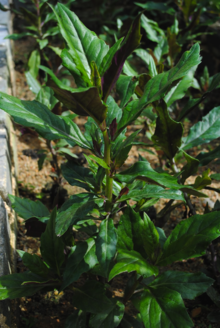Gynura bicolor
| Gynura bicolor | |
|---|---|

| |
| Hongfeng cai 紅鳳菜 plant | |
| Scientific classification | |
| Kingdom: | |
| (unranked): | |
| (unranked): | |
| (unranked): | |
| Order: | |
| Family: | |
| Tribe: | |
| Genus: | |
| Species: | G. bicolor
|
| Binomial name | |
| Gynura bicolor | |
| Synonyms[1] | |
| |
Gynura bicolor, hongfeng cai 紅鳳菜, okinawan spinach or edible gynura, is a member of the chrysanthemum family (Asteraceae). It is native to China, Thailand, and Myanmar but grown in many other places as a vegetable and as a medicinal herb.[2]
There are two kinds: one that is green on both sides, and another with leaves that are green on the top and purple underneath. Both kinds are considered medicinal vegetables. Gynura bicolor is a perennial and therefore found for sale throughout the year; however, winter and spring is the best time.[citation needed]
Uses
Gynura bicolor is rich in iron and potassium, calcium, vitamin A, etc. According to Chinese food grouping, Gynura bicolor is a 'cool' food,[3] so the leaves are stir-fried with sesame oil and ginger (both 'hotter' foods) to achieve a balance. The stems and roots of the plant can also be made into tea by boiling with water. Choose leaves with few bruises and without black stains.[citation needed] In Japan, Gynura bicolor is eaten as local vegetable in Ishikawa, Kumamoto and Okinawa and so on, blanched lightly and served with ponzu, as an ingredient of miso soup, or tempura.[citation needed]
Propagation
Taking cuttings is very easy.[4]
Toxicity
It was said that it can damage liver. Pyrrolizidine Alkaloids, toxic to the human liver, have been discovered in Gynura bicolor. [5] Weak cytotoxic activity was noted in an assay, validating that caution must be utilised when using Gynura bicolor.
Footnotes
- ^ The Plant List, Gynura bicolor (Roxb. ex Willd.) DC.
- ^ Flora of China, Gynura bicolor (Roxburgh ex Willdenow) Candolle, 1838. 红凤菜 hong feng cai
- ^ "Chinese Kitchen" (PDF). communitycenter.org.tw. Archived from the original (PDF) on 2012-09-16. Retrieved 2012-12-16.
- ^ "Taking cuttings". GreenTaiwan. Retrieved 2012-12-16.
- ^ Chen, J.; Lü, H.; Fang, L. X.; Li, W. L.; Verschaeve, L.; Wang, Z. T.; De Kimpe, N.; Mangelinckx, S. (2017). "Detection and Toxicity Evaluation of Pyrrolizidine Alkaloids in Medicinal Plants Gynura bicolor and Gynura divaricata Collected from Different Chinese Locations. Chen J., Lü H., Fang L.X., Li W.L., Verschaeve L., Wang Z.T., De Kimpe N., Mangelinckx S.. Chem Biodivers. 2017 Feb;14(2). doi: 10.1002/cbdv.201600221. Epub 2017 Jan 21". Chemistry & Biodiversity. 14 (2). doi:10.1002/cbdv.201600221. PMID 27623358.
External links
